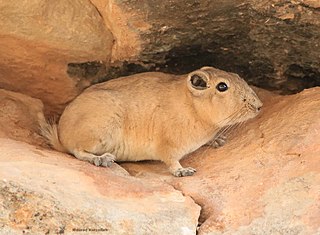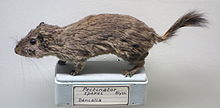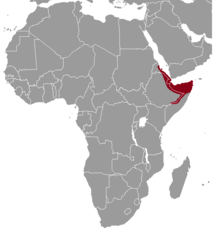Louise's spiny mouse is a species of rodent in the family Muridae. It is found in Djibouti, Ethiopia, Kenya, and Somalia. Its natural habitats are dry savanna, subtropical or tropical dry lowland grassland, and rocky areas.
The Kivu climbing mouse is a species of rodent in the family Nesomyidae. It is found in Burundi, Democratic Republic of the Congo, Rwanda, Malawi, Tanzania, Uganda, and Zambia. Its natural habitats are subtropical or tropical moist montane forests, subtropical or tropical high-altitude grassland, swamps, arable land, and plantations.
The banana climbing mouse is a species of rodent in the family Nesomyidae. It is found in Benin, Cameroon, Democratic Republic of the Congo, Nigeria, and Togo. Its natural habitat is subtropical or tropical dry lowland grassland.
The Ruwenzori thicket rat is a species of rodent in the family Muridae. It is found in Kenya, Malawi, South Sudan, Tanzania, Uganda, and Zambia. Its natural habitats are subtropical or tropical moist montane forests and subtropical or tropical high-altitude shrubland. It is threatened by habitat loss.
Macmillan's thicket rat is a species of rodent in the family Muridae. It is found in Central African Republic, Democratic Republic of the Congo, Ethiopia, Kenya, South Sudan, Tanzania, and Uganda. Its natural habitats are subtropical or tropical moist lowland forest, subtropical or tropical swamps, subtropical or tropical seasonally wet or flooded lowland grassland, shrub-dominated wetlands, and urban areas.
The Ethiopian thicket rat is a species of rodent in the family Muridae. It is found only in Ethiopia. Its natural habitat is subtropical or tropical dry shrubland. It is threatened by habitat loss.
The shining thicket rat is a species of rodent in the family Muridae.
The yellow-spotted brush-furred rat is a species of rodent in the family Muridae found in Angola, the Democratic Republic of the Congo, Ethiopia, Kenya, Malawi, Mozambique, South Sudan, Tanzania, and Zambia. Its natural habitats are subtropical or tropical moist lowland forest, subtropical or tropical moist montane forest, and subtropical or tropical high-altitude grassland. The population in Ethiopia is isolated and can be found at high altitudes up to 4,500 m above sea level.
Hutterer's brush-furred mouse or Hutterer's brush-furred rat is a species of rodent in the family Muridae. It is found only in Democratic Republic of the Congo, where its natural habitat is subtropical or tropical moist lowland forests.
The Mount Cameroon brush-furred rat or Rosevear's brush-furred mouse is a species of rodent in the family Muridae. It is found only in Cameroon. Its natural habitats are subtropical or tropical moist montane forests, subtropical or tropical moist shrubland, subtropical or tropical high-altitude shrubland, subtropical or tropical high-altitude grassland, plantations, and rural gardens.
The gray-bellied pygmy mouse is a species of rodent in the family Muridae. It is found in Angola, Burundi, Democratic Republic of the Congo, Kenya, Malawi, Mozambique, Rwanda, Tanzania, Uganda, and Zambia. Its natural habitats are subtropical or tropical moist montane forests, subtropical or tropical seasonally wet or flooded lowland grassland, subtropical or tropical high-altitude grassland, and arable land.

The common rufous-nosed rat is a species of rodent in the family Muridae. It is found in Angola, Burundi, Cameroon, Central African Republic, Republic of the Congo, Democratic Republic of the Congo, Equatorial Guinea, Ethiopia, Gabon, Kenya, Nigeria, Rwanda, South Sudan, Tanzania, and Uganda. Its natural habitats are subtropical or tropical seasonally wet or flooded lowland grassland and seasonally flooded agricultural land.
The bell groove-toothed swamp rat is a species of rodent in the family Muridae found in Angola and the Democratic Republic of the Congo. Its natural habitats are moist savanna, subtropical or tropical dry lowland grassland, arable land, and rural gardens.
Jackson's soft-furred mouse or Jackson's praomys is a species of rodent in the family Muridae. It is found in Angola, Burundi, Cameroon, Central African Republic, Republic of the Congo, Democratic Republic of the Congo, Equatorial Guinea, Gabon, Guinea, Kenya, Nigeria, Rwanda, South Sudan, Tanzania, Uganda, and Zambia. Its natural habitats are subtropical or tropical moist lowland forest, subtropical or tropical moist montane forest, arable land, and heavily degraded former forest.

The charming thicket rat is a species of rodent in the family Muridae. It is described as data deficient as Thamnomys schoutedeni. It is found in Democratic Republic of the Congo, Rwanda, and Uganda. Its natural habitat is subtropical or tropical moist montane forests. It is threatened by habitat loss.

The great-tailed triok is a species of marsupial in the family Petauridae. It is found in West Papua and Papua New Guinea. Its natural habitat is subtropical or tropical dry forests.

Ctenodactylus is a genus of rodent in the family Ctenodactylidae. It contains the following species :

The felou gundi is a species of rodent in the family Ctenodactylidae. It is monotypic within the genus Felovia.

The Mzab gundi is a species of rodent in the family Ctenodactylidae. It is monotypic within the genus Massoutiera. It is found in Algeria, Chad, Mali, Niger, and possibly Libya. The Mzab gundi can live in a variety of climates, including arid deserts with sparse vegetation and annual rainfall less than 20 mm. However, it lacks many of the adaptations other rodents use to cope with such extreme environments, instead relying on behavior to survive in those regions.

The common gundi is a species of rodent in the family Ctenodactylidae. It is found in Algeria, Libya, Morocco, and Tunisia. The parasitic organism Toxoplasma gondii was first described in 1908 in Tunis by Charles Nicolle and Louis Manceaux within the tissues of the gundi.










